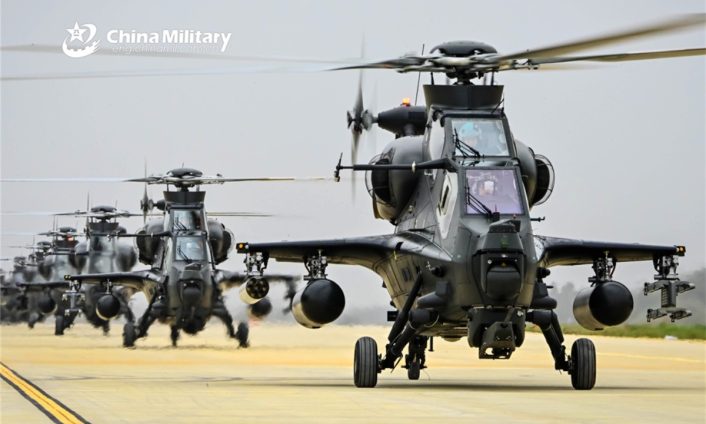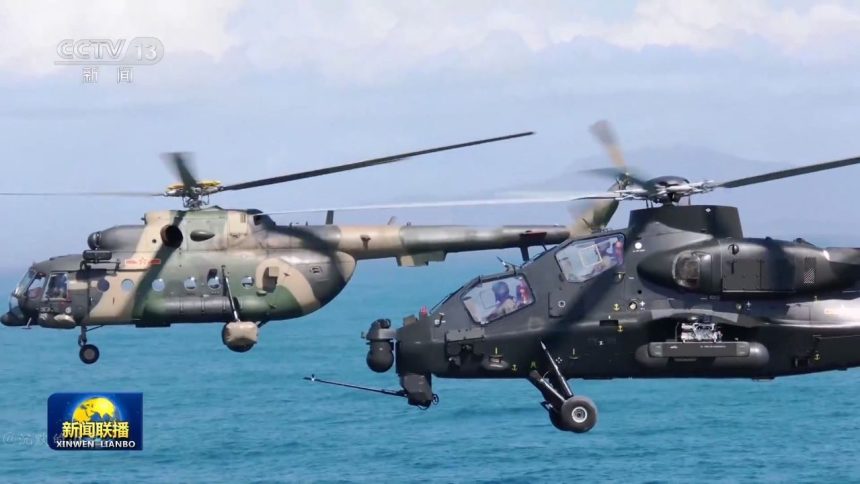The Z-10 would need organic EW capability in contested battle spaces and the KG300G EW pod serves this purpose.
A picture recently emerged online shows a PLA (People’s Liberation Army) Z-10 attack helicopter flying with a KG300G EW (Electronic Warfare) pod. Shared by leading Chinese military aviation researcher Andreas Rupprecht, the image shows the Z-10, flying alongside a Russian-origin Mi-8 helicopter, with the pod visible under the left stub wing.
It is not known whether the KG300G has been installed on the Z-10 as a permanent feature across operational units or on an experimental basis. Nevertheless, the pod’s appearance highlights the new age of contested battle spaces, which sees various airborne platforms sporting secondary EW, ESM (Electronic Support Measures) and ELINT (Electronic Intelligence) capabilities as the electromagnetic spectrum emerges as an increasingly important factor.
However, Martin Andrew, a 28 year veteran of the Australian Defense Force and analyst at the Jamestown Foundation who has authored the book ‘How the PLA Fights: Weapons and Tactics of the People’s Liberation Army’, commented on the post that the image appears to be photoshopped. Other comments seconded the claim, pointing to the inconsistent lighting and shadow patterns.
The pod
The KG300G has been reported in existence since 2007 on defense technology forums. Developed by CETC (China Electronic Technology Corporation), it has been described as an “airborne self-defense jammer pod,” operating in the I/J bands.
Via ACuriousPLAFan/SDF:
„First time a Z-10 spotted carrying the KG300G self-defense EW pod.
(Images via @沉默的山羊 and @电波震长空XYY from Weibo) pic.twitter.com/4pByGmcS81
— @Rupprecht_A (@RupprechtDeino) August 1, 2024
Rupprecht said in his post this is the first time a Z-10 has been spotted carrying the system. Earlier photos show a more rounded, cylindrical pod, while the one installed on the Z-10 in the picture has a more squared shape, in both its rear and front ends. Rupprecht also shared a separate close-up image of the new pod on a display stand, which better shows the new squared shape of the system.
The Z-10 in the picture is also an upgraded version of the helicopter that Chinese media first reported in Feb. 2020, featuring upward-facing exhaust outlets (to reduce infrared signature) and additional armor plating panels on the side chin, between the two cockpit canopies and on the turboshaft engines.
Use in Taiwan
For one, the image shows the two helicopters flying over the sea. Previous Chinese reports have claimed Z-10s with the 73rd Group Army of the Eastern Theater Command undertaking “day-and-night live-fire drills off the east coast of the Fujian province.”

The helicopters “took off in formation and headed toward designated areas, avoiding radar detection attempts through evasive maneuvers and low altitude flights and successfully launching attacks on maritime targets and targets on islands and reefs.” The War Zone also reported in May 2022 that a Z-10 entered Taiwan’s ADIZ (Air Defense Identification Zone) for the first time.
For an attack on Taiwan, the PLA would need a multiplicity of systems in a mutually supporting role, particularly while destroying ground targets as PLA Marine Brigades face heavy resistance from Taiwanese beach defenses, armor and artillery. Indeed, Chinese amphibious ZBD-05, ZTD-05 IFVs IFVs and light tanks would be sailing to Taiwanese shores while also firing their guns on shored encampments.
This would be alongside massive rocket artillery, cruise and tactical ballistic barrages on Taiwan’s rear fighting, command and control, logistical positions and air bases. Taiwan also received one batch of the U.S.-made FIM-92 Stinger MANPADS in May 2023. The weapons may pose a significant threat to PLA’s low-flying helicopters. The RoC (Republic of China) also operates the Humvee-mounted Avenger weapons system that fires the Stinger.
Nice images released by #PLA of Z-10 firing rocket and AKD-10 anti-tank missile over Tibetan plateau.
Good helo but not as good as AH-1Z or T-129 ATAK. Z-10’s engines & weapons are still in infancy stage not to mention lack of proper armour. pic.twitter.com/brbFLBcCR1
— ST (@aviation07101) April 4, 2021
Z-10 and Electronic Warfare
Heavy-class attack helicopters like the Z-21 would possibly have to fly at lower altitudes, closer to the ground, within range of these Taiwanese air defense missiles and guns. These helicopters will need heavy armor to withstand punishment, a larger weapons payload to suppress and destroy targets, and powerful EW systems to deflect incoming missiles.
The argument can be made that the Z-10’s weight class would not allow such a load, but that does not diminish the Z-10’s utility. It would still serve as the leading rotary wing attack platform, undertaking both close air support and long-range standoff fires. But at the same time, it would need organic survivability in the form of ELINT and ESM systems. The KG300G EW pod serves this purpose.
The Z-10’s export variant, the Z-10ME that debuted in the Singapore Air Show in Feb. 2024, for instance, features what look like MAWS (Missile Approach Warning Sensors) or RWRs (Radar Warning Receivers) on the sides of the chin and under the stub wings.
1/3 Detailed shots of the new 🇨🇳Z-10ME attack helicopter at 🇸🇬Singapore Airshow pic.twitter.com/Htqku6K8c7
— Jesus Roman (@jesusfroman) February 23, 2024
Going by open source pictures, the Z-10 variant used by China does not appear to sport the large rectangular arrays like the Z-10ME. But what it does appear to have are circular-shaped sensors that could be Laser Warning Receivers on the side chin. Some observers have assessed that the Z-10 could be supported by the Z-19, possibly for forward scouting and optical reconnaissance.
This is much like the OH-58D Kiowa Warrior that supported the US AH-64 Apache and presently performs the same role for Taiwanese Apaches. Interestingly, the Z-19 was one of the aircraft, the other being the JH-7 ground attack jet, that circled the Dutch warship HNLMS Tromp earlier in June in the SCS (South China Sea).
Lessons, tactics from Russia-Ukraine war
Seeing how Russia paired its Kamov Ka-52 Alligator and Mi-8MTPR-1 Electronic Warfare, or also Alligator and Mi-28 Havoc, in teaming tactics, China may adopt some of the same broad principles. A Feb. 2024 RAND Corporation study noted how the PLA might draw inspiration from Russia’s helicopter gunship tactics for Taiwan.
Nice images released by China Military of joint training exercise held by PLA Army & Navy in February.
Z-10 attack helicopter landing on Type-071 amphibious ship. Mil Mi 17 transport helicopters in formation with Z-10. #Jointness pic.twitter.com/V9ZZNAJx1C
— ST (@aviation07101) March 19, 2021
The threat to PLA Z-10 and Z-21s come from Taiwan’s domestically developed Sky Sword II (or TC-2) short-to-medium-range AD, which reports say can be used against rotary, fixed-wing aircraft, drones and cruise missiles in a somewhat point defense role. This missile is supported by a separate truck-mounted tracking radar for cueing, while the missile is likely to have active or passive radio frequency or radar seekers in its nose.
Likewise, against India in the disputed Himalayan territories, Chinese helicopters might face the Akash AD or the Israeli Spyder low-level quick reaction AD platform. The Spyder fires the Derby and Python-5 AAMs (Air-to-Air Missile) adapted for surface to air launch. While the Derby has an active RF seeker, the Python-5 sports a dual-band IR seeker.
Making it harder for adversary AD crews to track the Z-10, or get the missiles to lock and beat the jamming systems, affords a considerable tactical space to the helicopters. It can also force an adversary to expend more missiles to take down an EW-capable Z-10, forcing AD crews to also think about weapon stockpiles before opening fire and risk wasting precious missiles.









